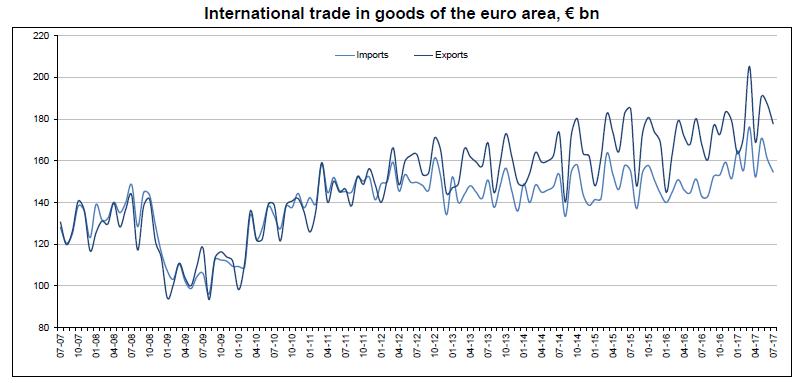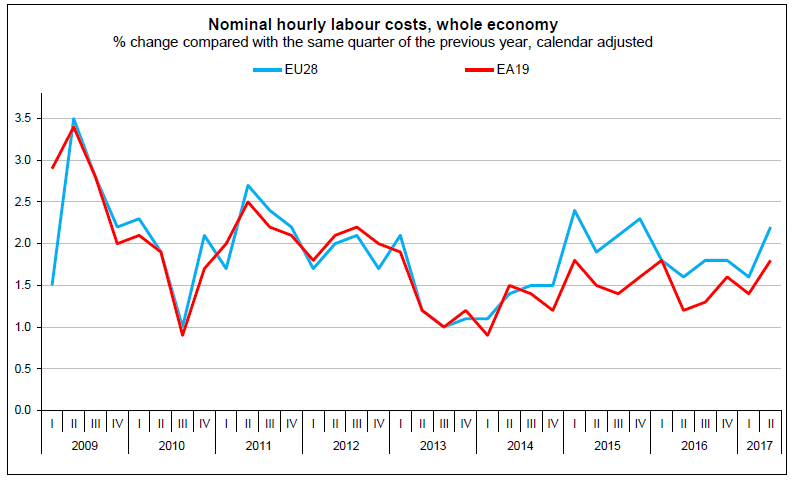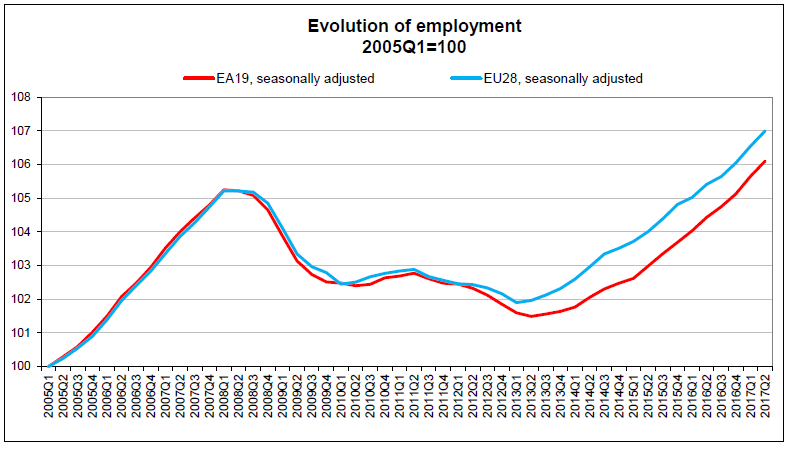Eurostat/Euro area international trade in goods surplus €23.2 bn/15 September 2017 The first estimate for euro area (EA19) exports of goods to the rest of the world in July 2017 was €177.7 billion, an increase of 6.1% compared with July 2016 (€167.6 bn). Imports from the rest of the world stood at €154.6 bn, a rise of 8.2% compared with July 2016 (€142.8 bn). As a result, the euro area recorded a €23.2 …Read More
In a Great Recession, the case for flexible exchange rates is alive and well
Corsetti, Giancarlo, Müller, Gernot, Kuester, Keith, (2017), “In a Great Recession, the case for flexible exchange rates is alive and well”, VoxEU, 16 September The classic rationale for flexible exchange rates was that policymakers would be unconstrained by currency targets. The Great Recession, however, saw numerous central banks constrained instead by the zero lower bound. This column considers which exchange rate regime is best for small open economies in a global …Read More
Drifting Apart: Income Convergence in the Euro Area
Franks, Jeffrey, Schölermann, Hanni, (2017), “Drifting Apart: Income Convergence in the Euro Area”, IMF Blog, 13 September The experience of recent decades has challenged the prediction that the single currency would help differences in income levels across euro area countries narrow over time. This income convergence among the founding countries of the euro has not happened, prompting a need for further economic reforms. While newer members of the euro have converged, …Read More
The Euro’s Narrow Path
Eichengreen, Barry, (2017), “The Euro’s Narrow Path”, (2017), Project Syndicate, 11 September With Emmanuel Macron’s victory in the French presidential election, and Angela Merkel’s Christian Democratic Union enjoying a comfortable lead in opinion polls ahead o Germany’s general election on September 24, a window has opened for eurozone reform. The euro has always been a Franco-German project. With a dynamic new leader in one country and a fresh popular mandate …Read More
Annual growth in labour costs at 1.8% in euro area
Eurostat/Annual growth in labour costs at 1.8% in euro area/15 September 2017 Hourly labour costs rose by 1.8% in the euro area (EA19) and by 2.2% in the EU28 in the second quarter of 2017, compared with the same quarter of the previous year. In the first quarter of 2017, hourly labour costs increased by 1.4% and 1.6% respectively. These figures are published by Eurostat, the statistical office of the European Union. Relevant …Read More
How has banking union changed mergers and acquisitions?
Goncalves Raposo, Ines, Wolff, Guntram B., (2017), “How has banking union changed mergers and acquisitions?”, Bruegel, 13 September The aim of the banking union was to break the toxic link between banks and states. One way of achieving this is by increasing cross border banking through mergers and acquisitions. This blog shows that little has changed in M&A activity since the banking union was launched. In fact, we seem to be …Read More
Employment up by 0.4% in both the euro area and in the EU28
Eurostat/Employment up by 0.4% in both the euro area and in the EU28/13 September 2017 The number of persons employed increased by 0.4% in both the euro area (EA19) and in the EU28 in the second quarter of 2017 compared with the previous quarter, according to national accounts estimates published by Eurostat, the statistical office of the European Union. In the first quarter of 2017, employment increased by 0.5% in …Read More
A Feasible Unemployment-Based Shock Absorber for the Euro Area
Brandolini, Andrea, Carta, Francesca, D’Amuri, Francesco, (2017), “A Feasible Unemployment-Based Shock Absorber for the Euro Area”, Journal of Common Market Studies, 54(5), pp. 1123-1141 Based on theoretical insights, this article identifies the broad characteristics that a shock absorber based on unemployment should have in order to be incentive-compatible and politically feasible. It then empirically derives the combination of activation thresholds, experience rating, eligibility criteria and benefit generosity which define the …Read More
Harmonised Unemployment Rates (HURs), OECD – Updated: September 2017
OECD/Harmonised Unemployment Rates (HURs)- Updated: September 2017/11 September 2017 The OECD unemployment rate was stable at 5.8% in July 2017, unchanged for the second consecutive month. Across the OECD area, 36.2 million people were unemployed, 3.6 million more than in April 2008. Relevant Posts OECD, (2017), «Jobs gap closes but recovery remains uneven», 13 June Garda, Paula, (2017), «Employment ins and outs in OECD countries», OECD, 30 March
Headline inflation measures shouldn’t ignore costs of home ownership
Hampl, Mojmir, Havranek, Tomas, (2017), “Headline inflation measures shouldn’t ignore costs of home ownership”, VoxEU, 12 September Seven out of every ten Europeans live in their own homes, yet Europe’s most important inflation measure excludes the costs associated with owner-occupied housing. This column argues that including the costs of home ownership would prove beneficial to the conduct of monetary and macroprudential policy. It would also bring the measure closer to …Read More








